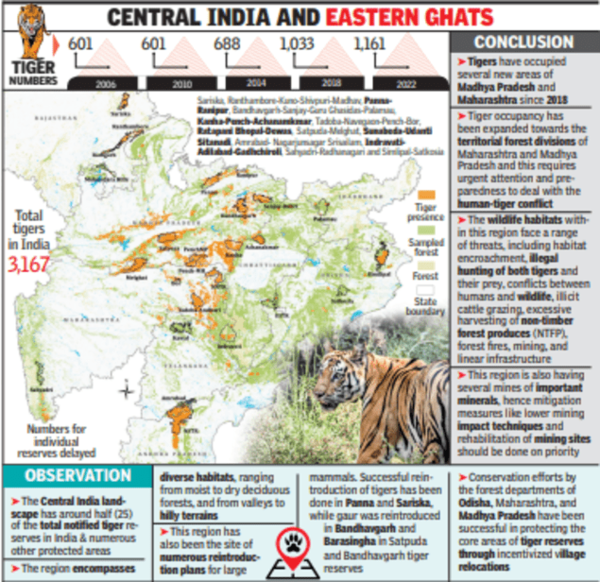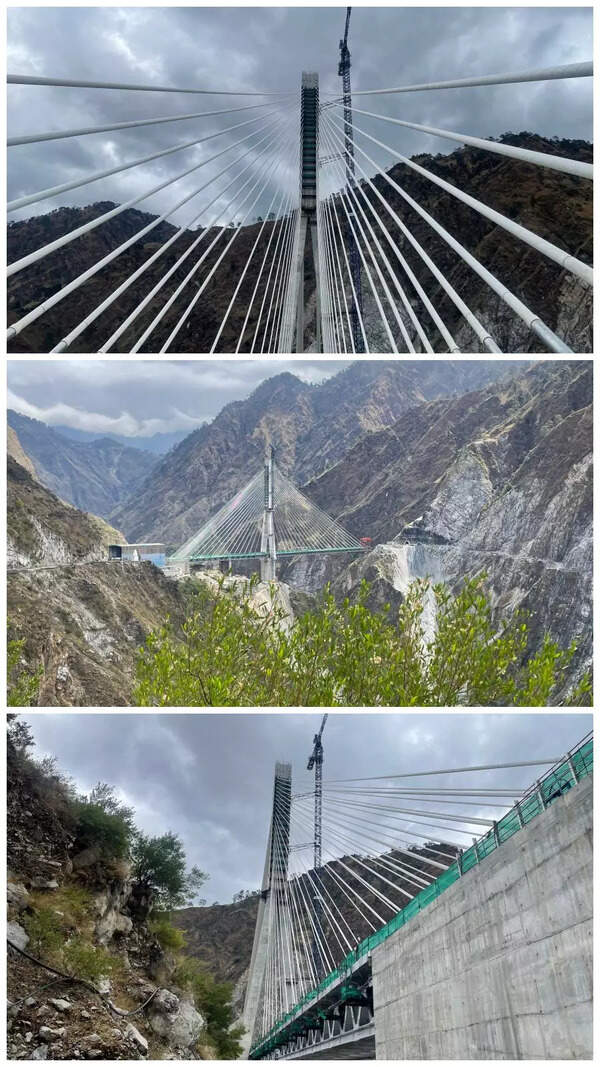- News
- City News
- nagpur News
- Central India has world’s highest tiger count; Maharashtra, Madhya Pradesh play big role
Trending Topics
Central India has world’s highest tiger count; Maharashtra, Madhya Pradesh play big role

Image used for representational purpose only
NAGPUR: Of the 200 tigers added to the 2,967 estimated in 2018, taking the count to 3,167 as per the latest ‘Status of Tiger Report’, 128 are from the Central India Landscape (CIL). This makes it clear that Maharashtra and Madhya Pradesh (MP) have played a big role in increasing the tiger numbers in the country.
“This means, Central India has largest population of tigers in the world,” said Bilal Habib, Wildlife Institute of India scientist. As per the 2018 estimates, there were 1,033 tigers in Central India and the Eastern Ghats Landscape, which comprises tiger reserves in Maharashtra, MP, Chhattisgarh, Telangana, Andhra Pradesh, Odisha and Rajasthan. However, the latest report estimates 1,161 tigers, an increase of 128.

National Tiger Conservation Authority (NTCA) and Wildlife Institute of India (WII) officials say the addition to the national figure of 3,167 tigers must be from Maharashtra and MP and Shivalik Landscape, which have done well.
“Tiger signs were detected in 1,049 grids and 1,161 unique tigers were photo-captured. As per the distribution of tigers in Central India and Eastern Ghats Landscape, the big cats have occupied several territorial areas of MP and Maharashtra that were not occupied in 2018,” the report states.
Anish Andheria, president, Wildlife Conservation Trust (WCT), said, “State-wise tiger numbers are not yet out. However, looking at the region-wise break-up in the preliminary report, there are 128 more unique tiger photo-captures in Central Indian Highlands and Eastern Ghats in 2022 as compared to 2018.”
“From the understanding of this region, I can safely say that MP and Maharashtra must have contributed in a big way to this increase. Telangana, Chhattisgarh, Jharkhand, Odisha, and parts of Andhra Pradesh and Bihar, included in this region, haven’t done much the last decade, and are unlikely to have contributed much to the AITE-2022,” Andheria said.
“It is beyond doubt that tiger occupancy has been expanded towards the territorial forest divisions of Maharashtra and MP. However, this expansion calls for urgent attention and preparedness to deal with negative human-tiger interactions,” as per the report.
According to Nitin Desai, Central India director of Wildlife Protection Society of India, tiger population has grown particularly Maharashtra and MP due to anti-poaching measures along with better management practices. “If the upward trend has to be maintained, issues like human-tiger conflict, fragmentation of corridors, illegal power farm fences, poaching, grazing, and fuelwood collection have to be dealt with seriously,” Desai said.
In Maharashtra, over 104 people have died in the conflict, pointed out Bandu Dhotre, ex-state wildlife board member. “Of this, 90% of attacks by tigers and leopards were in Chandrapur and Gadchiroli districts alone. Even as the number of tiger deaths was high during the last four years, new entrants were more than the mortality rate,” he said.
The Ranthambhore tiger population (only source population) has contributed to the expansion of tiger distribution in the semi-arid landscape of western India (Dholpur, Kuno-Shivpuri, Ramgarh Visdhari). However, tiger occupancy declined in the states of Jharkhand, Odisha, Chhattisgarh and Telangana.
Tigers were locally extirpated from Kawal and Chennur of Telangana, Sri Venkateswara National Park in Andhra Pradesh, Satkosia from Odisha, and Sahyadri from Maharashtra and Andhra Pradesh. The genetically unique and small population of tigers in Simlipal is of high conservation priority in the landscape.
The CIL is a vast network of protected areas with around 25 of the total notified tiger reserves and PAs that contain extensive tiger-occupied forests. The region encompasses diverse habitats.
“Serious conservation efforts are needed to help tiger population recovery in Jharkhand, Odisha, Chhattisgarh, Telangana and Andhra Pradesh,” said BK Singh, ex-PCCF, Karnataka.
“This means, Central India has largest population of tigers in the world,” said Bilal Habib, Wildlife Institute of India scientist. As per the 2018 estimates, there were 1,033 tigers in Central India and the Eastern Ghats Landscape, which comprises tiger reserves in Maharashtra, MP, Chhattisgarh, Telangana, Andhra Pradesh, Odisha and Rajasthan. However, the latest report estimates 1,161 tigers, an increase of 128.

National Tiger Conservation Authority (NTCA) and Wildlife Institute of India (WII) officials say the addition to the national figure of 3,167 tigers must be from Maharashtra and MP and Shivalik Landscape, which have done well.
“Tiger signs were detected in 1,049 grids and 1,161 unique tigers were photo-captured. As per the distribution of tigers in Central India and Eastern Ghats Landscape, the big cats have occupied several territorial areas of MP and Maharashtra that were not occupied in 2018,” the report states.
Anish Andheria, president, Wildlife Conservation Trust (WCT), said, “State-wise tiger numbers are not yet out. However, looking at the region-wise break-up in the preliminary report, there are 128 more unique tiger photo-captures in Central Indian Highlands and Eastern Ghats in 2022 as compared to 2018.”
“From the understanding of this region, I can safely say that MP and Maharashtra must have contributed in a big way to this increase. Telangana, Chhattisgarh, Jharkhand, Odisha, and parts of Andhra Pradesh and Bihar, included in this region, haven’t done much the last decade, and are unlikely to have contributed much to the AITE-2022,” Andheria said.
“It is beyond doubt that tiger occupancy has been expanded towards the territorial forest divisions of Maharashtra and MP. However, this expansion calls for urgent attention and preparedness to deal with negative human-tiger interactions,” as per the report.
According to Nitin Desai, Central India director of Wildlife Protection Society of India, tiger population has grown particularly Maharashtra and MP due to anti-poaching measures along with better management practices. “If the upward trend has to be maintained, issues like human-tiger conflict, fragmentation of corridors, illegal power farm fences, poaching, grazing, and fuelwood collection have to be dealt with seriously,” Desai said.
In Maharashtra, over 104 people have died in the conflict, pointed out Bandu Dhotre, ex-state wildlife board member. “Of this, 90% of attacks by tigers and leopards were in Chandrapur and Gadchiroli districts alone. Even as the number of tiger deaths was high during the last four years, new entrants were more than the mortality rate,” he said.
The Ranthambhore tiger population (only source population) has contributed to the expansion of tiger distribution in the semi-arid landscape of western India (Dholpur, Kuno-Shivpuri, Ramgarh Visdhari). However, tiger occupancy declined in the states of Jharkhand, Odisha, Chhattisgarh and Telangana.
Tigers were locally extirpated from Kawal and Chennur of Telangana, Sri Venkateswara National Park in Andhra Pradesh, Satkosia from Odisha, and Sahyadri from Maharashtra and Andhra Pradesh. The genetically unique and small population of tigers in Simlipal is of high conservation priority in the landscape.
The CIL is a vast network of protected areas with around 25 of the total notified tiger reserves and PAs that contain extensive tiger-occupied forests. The region encompasses diverse habitats.
“Serious conservation efforts are needed to help tiger population recovery in Jharkhand, Odisha, Chhattisgarh, Telangana and Andhra Pradesh,” said BK Singh, ex-PCCF, Karnataka.
Start a Conversation
FOLLOW US ON SOCIAL MEDIA
FacebookTwitterInstagramKOO APPYOUTUBE










